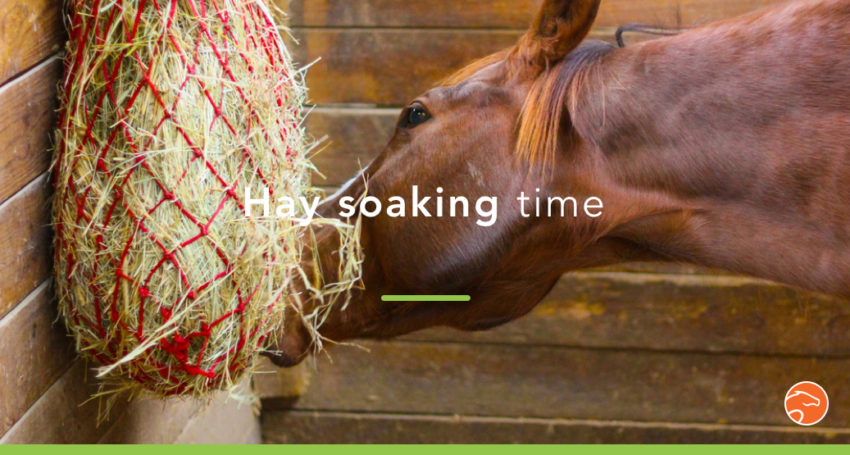
How Long Should you Soak Your Horse’s hay for?
Do you soak your horse’s hay? Those who have an emphysematous or overweight horse know what I’m talking about … This need of having to fill the trash cane with water, immerse the hay in it, take it out of the water, drain it, etc. With this eternal question always in the back of our heads: how long should I soak the hay for? It is indeed a good question, you will see that there are many answers to it! ⏬
Table des matières
- Stable barns are full of dust!
- What happens to the hay when soaked?
- For how long does the hay need to soak then?
- 💡Destrier‘s advice in order to make your horse lose weight:
- 💡Destrier‘s advice concerning horses’ suffering from myositis:
- Do all types of hay react the same when soaked?
- Is there an alternative to soaking hay?
- Conclusion
Stable barns are full of dust!
To say the least! Because the air in a stable has on average 3000 respirable particles per milliliter. In a single inspiration, a horse inhales nearly 12 million dust particules😬 (just that!).
Among them, we find all kinds of things: sand, dirt but also bacteria, viruses and other fungi spores or debris of plants or insects. That’s about what you can find on your tissue when picking your nose😋.
The problem is that these particles are likely to travel very deeply into the respiratory system (sometimes to the pulmonary alveoli). However, the horse is an athlete whose airways are highly stressed during physical exertion. Thus, the amount of dust inhaled can have a big impact on its performance, or even on his overall health. It is likely that if human athletes lived in stables, their performance would be strongly impacted …
📚 Read more: 6 “must know” on the horse’s respiratory system
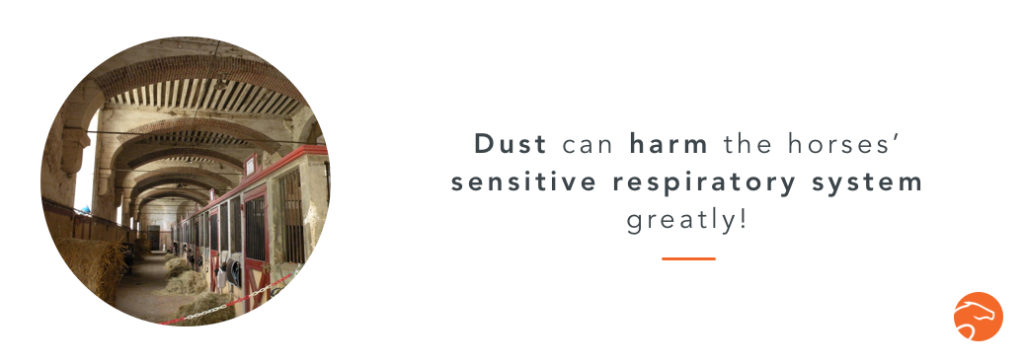
What happens to the hay when soaked?
When hay is immersed in water, the respirable particles contained in it are taken by the liquid and end up in the soaking water. That’s why we often advise soaking hay for horses suffering from emphysema (also called “heaves”) who are allergic to dust.
However, the reduction of particles is not the only consequence of soaking. In fact, the plant cells’ walls get damaged and are unable to regulate the entry of water. The soluble cellular content is therefore taken in the water. We are talking here about soluble sugars, proteins or minerals, all elements with a nutritional interest. This leads to a decrease in the nutritional value of the hay. For this reason, it is advisable to soak your horse’s hay in order to make him lose weight (or not to get any fatter).
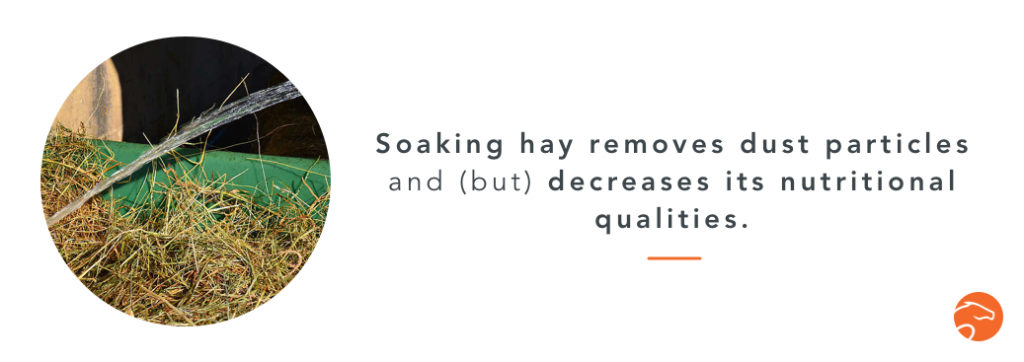
📚Read more: “Cereal free” feed: dietarily interesting or marketing move?
For how long does the hay need to soak then?
Well, the answer depends on your intentions. Do you want to limit dust intake without impacting nutritional values or do you want to make the hay less nutritious? It depends on your horse’s needs. A short tour:
#1 Emphysema or heaves
⏱ For emphysema, hay should be soaked for 20 min
Knowing that it takes between 5 to 30 minutes of soaking to remove about 95% of respirable particles [1] [2], 20 minutes seems to be a good compromise. We know that it takes about 24 hours to eliminate 99% of the dust [1] [2] but it seems useless to degrade the nutritional intake of the hay in order to earn a few unfortunate percent.
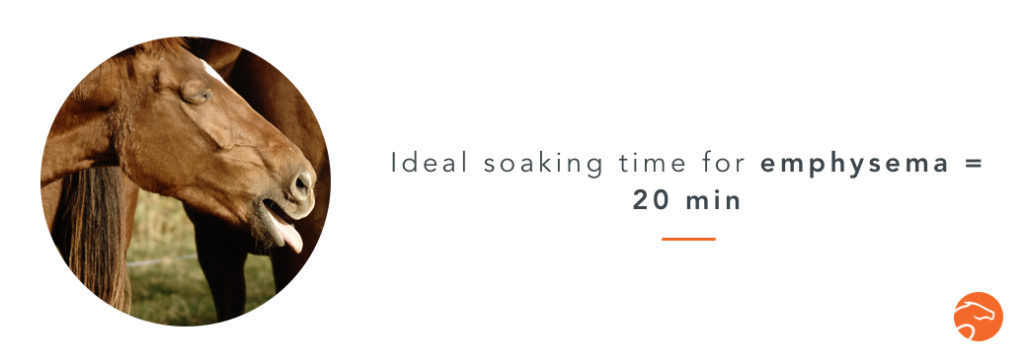
📚Read more: 8 Things to Know About Recurrent Airway Obstruction
#2 Overweight or obesity
⏱ For overweight horses, hay should be soaked for about 5 to 10 hours
That’s about the time between two meals! According to some studies, such a soaking time reduces soluble sugars by 2 to 54% and proteins by 2 to 15% (this depending on the hay quality) [2]. For overweight horses, feeding soaked hay along the day seems like a good way to put them on a diet.
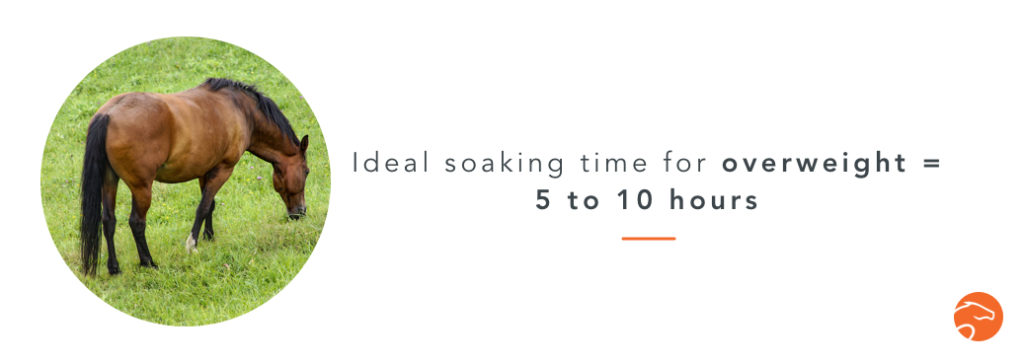

💡Destrier‘s advice in order to make your horse lose weight:
For a drastic diet, remove the food and secure micronutrient intakes with Destrier Mineral
For a more forgiving diet, substitute all or part of the food by the Synchro Destrier.
Feel free to reduce the pasture area (if not the time), especially in spring.
#3 Equine Metabolique Syndrome (EMS)
⏱ For ESM, hay should be soaked for 5 to 10 hours
Although this is a rare metabolic disease, EMS is characterized by weight gain as well as a permanent and abnormal increase in blood glucose and insulin levels. For these horses, soaked hay has the advantage of limiting the peaks of blood glucose and insulinemia compared to dry hay or haylage [3].
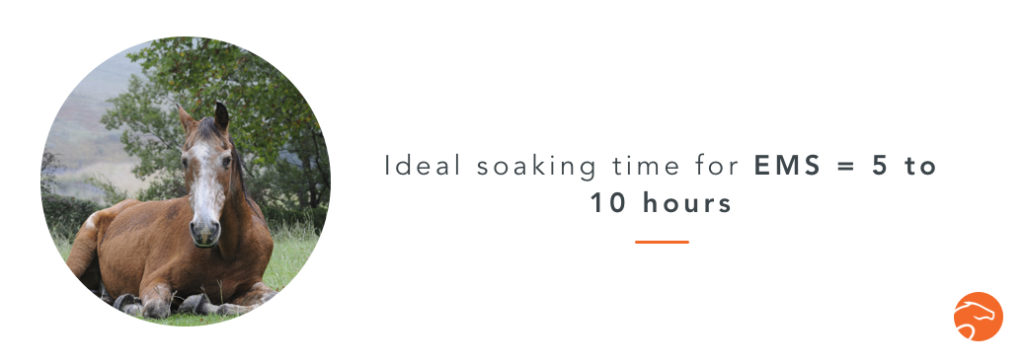
#4 Myositis
⏱ For myositis, hay should be soaked for 5 to 10 hours
For a horse suffering from recurrent myositis (RER: Recurrent Exercise Myopathy or PSSM: Myositis by Polysaccharide Overload), it is advisable to substitute some of the carbohydrate energy (starch and sugars) of his ration by lipid energy.
In reality and unfortunately, a great decrease in fructans concentration (sugars in the grass) is difficult to achieve only by soaking the hay. 😕
A starch-poor feed program combined with good practices (feed distribution, training and stable) are usually the first steps to take. However, for a horse with a high rate of recurrence, which would tend to have crises with each feed transition (eg: new hay supply), soaking the hay can be a complementary measure. Indeed, it helps to keep the horse below its threshold for triggering crises. In this case and if you can, choose hay with at least 50% of grasses as it is less rich in fructans [5].
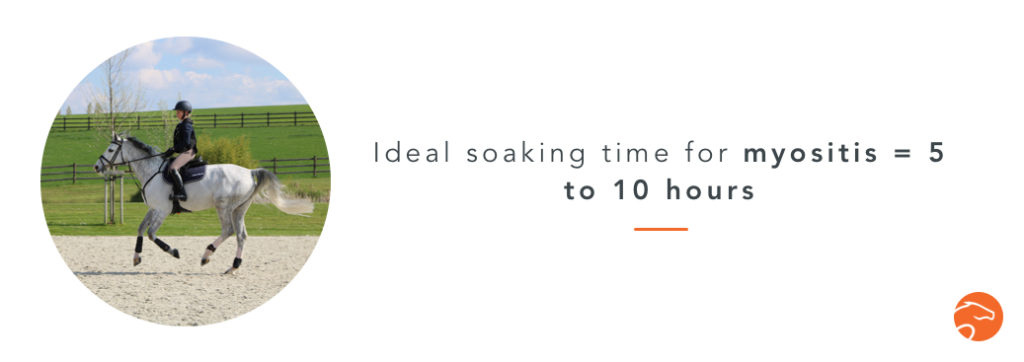
📚Read more: The horse’s myositis: What can i do?

💡Destrier‘s advice concerning horses’ suffering from myositis:
For a 500 kg horse, feed:
7 to 9 kg of hay a day, with at least 50% of spied grasses
3 to 10L of Destrier Racing Fiber (depleted in starch and rich in fat), adjust it according to your horse’s level of activity.
#4 Laminitis
⏱ For laminitis, hay should be soak for 5 to 10 hours
Sugars, and especially fructans are laminitis triggers. As in the case of myositis, it is difficult to reduce the fructan concentration sufficiently by soaking. Soaking the hay is an emergency measure, to promote extra help when the crisis is triggered.
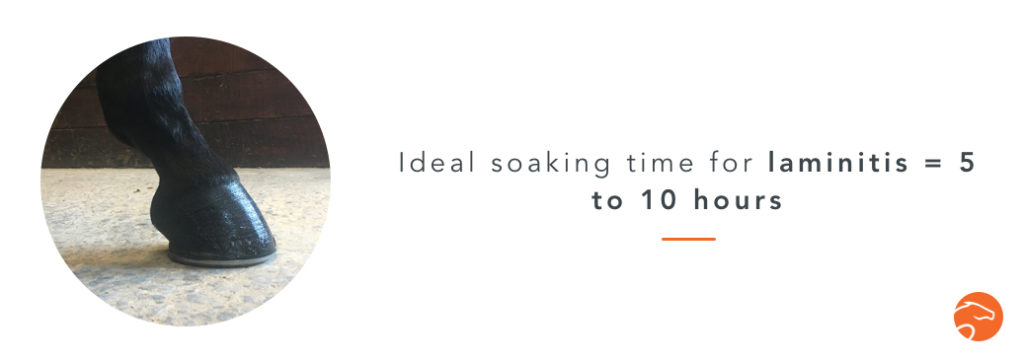
Do all types of hay react the same when soaked?
No, it would be way too easy otherwise 😈 There are as many qualities of hay as … hay types.
This quality depends on the weather of the area, the soil, the degree of ripeness during the cut, methods of drying and storage etc. Thus, the nutritional parameters of hay can vary significantly. It is the quality of initial dried hay that determines the nutritional values of the soaked hay.
Overall, and unsurprisingly, the lower the nutritional quality of the hay, the greater the loss in energy, proteins, sugar and minerals [4]. To complicate everything a little more (because otherwise, it would not be funny …), know that the same batch of hay, even the same bale of hay, can be heterogeneous 😱.

Carry out regular hay analyzes (for each incoming forage if you have a particularly sensitive horse).
=>Destrier’s technicians are well equipped to do such analysises. 👍
Is there an alternative to soaking hay?
Yes, steam treatment but only for emphysematous horses! Indeed, this method has the advantages of soaking without the disadvantage of nutritional depreciation 💪.
This technology reduces respirable particles by 98% without altering the nutritional quality of the feed. In addition, it is more environmentally friendly: not only does it consume less water, it also does not release pollutants into the environment (unlike soaking water).
This technique however remains expensive: count between 1000 € and 2800 € for purchasing the machine and 3.10 € to 3.90 € per day for a 500 kg horse fed with 10 kg of hay per day [1].
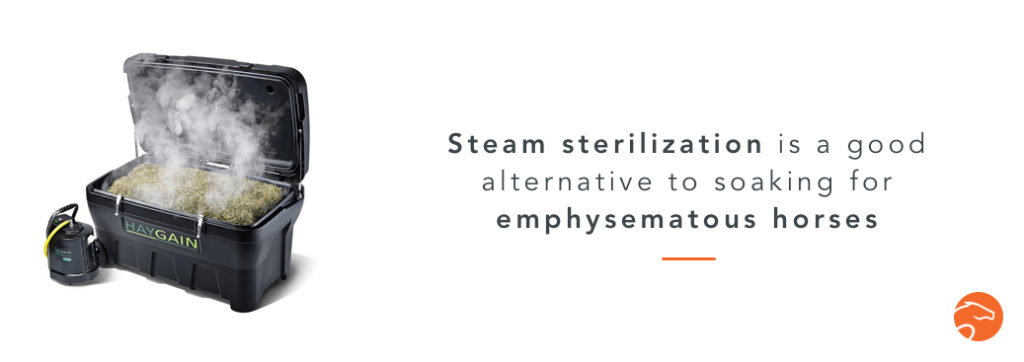
Conclusion
As you have understood, the soaking time of hay is only a compromise between the desired objective and the associated nutritional losses. In addition, it is interesting to know the initial quality of your forage due to all hays not being the same therefore, with different nutritional losses during soaking.
Although this practice provides solutions, it must be kept in mind that the best way to fight emphysema is a good stable hygiene and adequate ventilation, and that the best way to fight against the other diseases mentioned above remains establishing a specific and adapted feeding program.
Marine Slove,
Veterinarian and nutritionist Destrier
Bibliography :
[1] Blackman M., Moore-Coyler M.J.S., 1998. Hay for horses: the effects of three different wetting treatments on dust and nutrient content. Animal Science 66: 745-750.
[2] Warr E., Petch J., 1992. Effects of soaking hay on its nutritional quality. Equine Veterinary Education 5: 169-171.
[3] Carslake H.B., McG. Argo C., Pinchbeck G.L., Dugdale A.H.A., McGowan C.M., 2018. Insulinaemic and glycaemic responses to three forages in ponies. The Veterinary Journal 235: 83-89.
[4] A. Bleuse, “Le trempage du foin : pertes nutritionnelles et recommandations pour les Equidés”, Essai terrain, R&D Néovia, 2019.
[5] Kaeffer C., 2018. Alimenter un cheval PSSM: 1. Le fourrage. Publié le 10 mai 2018 sur le blog “Techniques d’élevage” et consulté le 09.08.2019. http://www.techniquesdelevage.fr/2018/05/alimenter-un-cheval-pssm-1.le-fourrage.html
Images :
Wet hay – IFCE ©N. Genoux